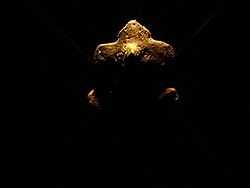Guatimac

Guatimac is an owl-shaped Guanche idol figurine, found in 1885 surrounded by the skin of goat and hidden in a cave in Fasnia (Tenerife, Canary Islands, Spain).
It is related to the magical and religious world of the Guanches. It represents a protective spirit in the form of an owl and was used by priests of the Guanche civilization.[1] It is believed that the Guatimac represents the internal world, the spirit of the Guanche soldier. At the site of the discovery of the idol had been found in the 18th century, a large number of Guanche mummies in a cave-tomb.
Guatimac represents a rarity in idols known in the Canary Islands, it is not similar among the remains of the ancient inhabitants of the archipelago not even own island of Tenerife. However, in North Africa in the cultural area of influence Libyan-Berber rock carvings found in caves in the desert some evil geniuses, Yenum or Djenun.[2] The performances of these geniuses have a striking resemblance to the Guanche figurine called Guatimac. Therefore idol Guanche iconography could represent a widespread belief throughout the North African Berber cultural field and therefore also in the Canary Islands, because the aboriginal Guanches came from North Africa and were culturally Berbers. However, it remains an enigma that has not been found to Guatimac similar figures in other islands or other places of the island of Tenerife itself.[3]
The idol has a hole through which a belt could be passed so it could be hung around the neck. Images similar to the Guatimac idol were used by Guanche priests. Despite its small size, only about 6.4 inches (16 cm) tall, it has great anthropological value, since it is one of the few idols of prehistoric Tenerife that have survived to today. It is currently housed in the Archaeological Museum of Puerto de la Cruz.[1]
References
- ↑ 1.0 1.1 Guatimac, TodoTenerife.es
- ↑ La Religión de Arena. Una revisión de la idolatría guanche a la luz de las fuentes históricas.
- ↑ La Religión de Arena. Una revisión de la idolatría guanche a la luz de las fuentes históricas.